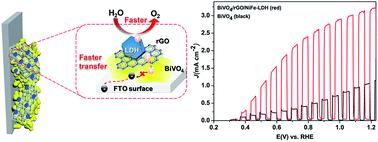当前位置:
X-MOL 学术
›
J. Mater. Chem. A
›
论文详情
Our official English website, www.x-mol.net, welcomes your
feedback! (Note: you will need to create a separate account there.)
Identifying dual functions of rGO in a BiVO4/rGO/NiFe-layered double hydroxide photoanode for efficient photoelectrochemical water splitting
Journal of Materials Chemistry A ( IF 10.7 ) Pub Date : 2020-06-22 , DOI: 10.1039/d0ta04572a Hua Chen 1, 2, 3, 4, 5 , Songcan Wang 5, 6, 7, 8, 9 , Jianzhong Wu 1, 2, 3, 4 , Xiacong Zhang 2, 3, 4, 10, 11 , Jia Zhang 1, 2, 3, 4 , Miaoqiang Lyu 5, 6, 7, 8, 9 , Bin Luo 5, 6, 7, 8, 9 , Guangren Qian 1, 2, 3, 4 , Lianzhou Wang 5, 6, 7, 8, 9
Journal of Materials Chemistry A ( IF 10.7 ) Pub Date : 2020-06-22 , DOI: 10.1039/d0ta04572a Hua Chen 1, 2, 3, 4, 5 , Songcan Wang 5, 6, 7, 8, 9 , Jianzhong Wu 1, 2, 3, 4 , Xiacong Zhang 2, 3, 4, 10, 11 , Jia Zhang 1, 2, 3, 4 , Miaoqiang Lyu 5, 6, 7, 8, 9 , Bin Luo 5, 6, 7, 8, 9 , Guangren Qian 1, 2, 3, 4 , Lianzhou Wang 5, 6, 7, 8, 9
Affiliation

|
Bismuth vanadate (BiVO4) is a promising material for photoelectrochemical (PEC) water oxidation. However, the sluggish water oxidation kinetics, poor electron transport properties and severe charge recombination limit its performance. Here, a new type of triadic photoanode is developed by rationally designing the electrode structure. The NiFe-layered double hydroxide (NiFe-LDH) serves as a water oxidation catalyst (WOC) to accelerate the transportation of the photo-generated holes from the BiVO4 photoelectrode to the electrolyte for improving the water oxidation reaction, while the reduced graphene oxide (rGO) nanosheets serve as an efficient electron shuttling mediator for suppressing the electron–hole recombination at the BiVO4/NiFe-LDH interfaces. On the other hand, rGO can positively shift the electrodeposion potential of NiFe-LDH (−0.1 V vs. RHE) which can greatly protect the BiVO4 electrode, since a more negative potential would reduce its PEC activity. This electrode exhibits a significantly higher photocurrent density than those of its pristine BiVO4, BiVO4/rGO, and BiVO4/NiFe-LDH counterparts, producing a photocurrent density of 3.26 mA cm−2 at 1.23 V vs. RHE under AM 1.5 G illumination and showing excellent stability. The improved PEC performance is attributed to the accelerated charge separation/transfer between the photoanode/electrolyte interfaces and surface water oxidation reaction due to the synergistic effect of rGO and NiFe-LDH.
中文翻译:

识别BiVO4 / rGO / NiFe层状双氢氧化物光阳极中rGO的双重功能,以实现有效的光电化学水分解
钒酸铋(BiVO 4)是一种有前途的光电化学(PEC)水氧化材料。但是,缓慢的水氧化动力学,较差的电子传输性能和严重的电荷重组限制了其性能。在此,通过合理设计电极结构,开发了新型的三重光电阳极。NiFe层状双氢氧化物(NiFe-LDH)用作水氧化催化剂(WOC),以加速光生空穴从BiVO 4光电极到电解质的传输,从而改善水氧化反应,同时还原氧化石墨烯(rGO)纳米片可作为有效的电子穿梭介体,用于抑制BiVO 4处的电子-空穴复合/ NiFe-LDH接口。另一方面,rGO可以使NiFe-LDH的电沉积电势正向移动(-0.1 V对RHE),可以极大地保护BiVO 4电极,因为负电势会降低其PEC活性。该电极显示出比其原始BiVO 4,BiVO 4 / rGO和BiVO 4 / NiFe-LDH对应物更高的光电流密度,在1.23 V vs. 23V下产生3.26 mA cm -2的光电流密度。RHE在AM 1.5 G照明下显示出出色的稳定性。PEC性能的提高归因于rGO和NiFe-LDH的协同作用,促进了光阳极/电解质界面之间电荷的分离/转移以及表面水的氧化反应。
更新日期:2020-07-07
中文翻译:

识别BiVO4 / rGO / NiFe层状双氢氧化物光阳极中rGO的双重功能,以实现有效的光电化学水分解
钒酸铋(BiVO 4)是一种有前途的光电化学(PEC)水氧化材料。但是,缓慢的水氧化动力学,较差的电子传输性能和严重的电荷重组限制了其性能。在此,通过合理设计电极结构,开发了新型的三重光电阳极。NiFe层状双氢氧化物(NiFe-LDH)用作水氧化催化剂(WOC),以加速光生空穴从BiVO 4光电极到电解质的传输,从而改善水氧化反应,同时还原氧化石墨烯(rGO)纳米片可作为有效的电子穿梭介体,用于抑制BiVO 4处的电子-空穴复合/ NiFe-LDH接口。另一方面,rGO可以使NiFe-LDH的电沉积电势正向移动(-0.1 V对RHE),可以极大地保护BiVO 4电极,因为负电势会降低其PEC活性。该电极显示出比其原始BiVO 4,BiVO 4 / rGO和BiVO 4 / NiFe-LDH对应物更高的光电流密度,在1.23 V vs. 23V下产生3.26 mA cm -2的光电流密度。RHE在AM 1.5 G照明下显示出出色的稳定性。PEC性能的提高归因于rGO和NiFe-LDH的协同作用,促进了光阳极/电解质界面之间电荷的分离/转移以及表面水的氧化反应。











































 京公网安备 11010802027423号
京公网安备 11010802027423号